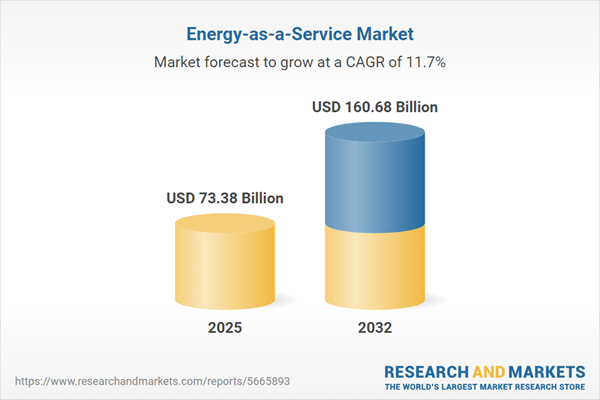Speak directly to the analyst to clarify any post sales queries you may have.
The Energy-as-a-Service Market is experiencing significant transformation as enterprises seek reliable and sustainable solutions for their evolving energy needs. This shift is driving innovation, broadening service options, and supporting strategic growth across various industry segments.
Market Snapshot: Energy-as-a-Service Market Growth and Outlook
The Energy-as-a-Service Market grew from USD 66.15 billion in 2024 to USD 73.38 billion in 2025. It is expected to continue growing at a CAGR of 11.73%, reaching USD 160.68 billion by 2032.
This expansion is propelled by advanced energy technologies, evolving consumer demands, and increasingly supportive regulatory frameworks worldwide.Scope & Segmentation
This report provides a comprehensive assessment of market dynamics and segmentation, enabling actionable insights for informed decision-making:
- Service Model
- Energy Infrastructure Services: Includes EV Charging-as-a-Service, Microgrid-as-a-Service, Storage-as-a-Service
- Energy Management Services: Comprises Demand Response Services, Energy Audit Services, Energy Efficiency Services
- Energy Supply Services: Covers Biomass-as-a-Service, Solar-as-a-Service, Wind-as-a-Service
- Financing Services: Entails Energy Performance Contracting, Lease Services, Power Purchase Agreement
- Business Model
- Leasing
- Pay-per-Use
- Performance Contracting
- Subscription-based
- End User
- Commercial: Corporate Offices, Hospitality, Retail Spaces
- Industrial: Food & Beverage, Manufacturing Plants, Metallurgical Sites, Textile Production
- Institutional: Education Facilities, Government Buildings, Healthcare Institutions
- Residential: Apartment Buildings, Single-Family Homes
- Utility Companies: Regional Utilities, Transmission Operators
- Service Provider
- In-House Services
- Independent Service Providers
- Regions Covered
- Americas: United States, Canada, Mexico, Brazil, Argentina, Chile, Colombia, Peru
- Europe, Middle East & Africa: United Kingdom, Germany, France, Russia, Italy, Spain, Netherlands, Sweden, Poland, Switzerland, United Arab Emirates, Saudi Arabia, Qatar, Turkey, Israel, South Africa, Nigeria, Egypt, Kenya
- Asia-Pacific: China, India, Japan, Australia, South Korea, Indonesia, Thailand, Malaysia, Singapore, Taiwan
- Leading Companies Profiled
- ABB Ltd, Alpiq Holding Ltd., Ameresco, Bernhard, Centrica plc, EDF Renewables SA, Emerson Electric Company, Enel S.p.A., ENEL X INTERNATIONAL S.R.L., Engie Group, Entegrity Energy Partners, GE Vernova Inc., Hitachi India Limited, Honeywell International, Johnson Controls International, Mitsubishi Electric Corporation, Rockwell Automation, Schneider Electric SE, Siemens AG, SMA Solar Technology AG, Veolia Environnement SA, Wärtsilä Oyj Abp, Ørsted A/S, Berkeley Energy Group, Redaptive, Inc.
Key Takeaways: Strategic Insights for Senior Leaders
- Energy-as-a-Service drives a transition to outsourced, performance-driven models, freeing organizations from direct asset ownership and enabling predictable cost management.
- Service providers are rapidly innovating with flexible financing, modular technologies, and digitally enabled platforms to align with customer objectives and sector-specific requirements.
- End users—including commercial, industrial, institutional, and residential sectors—increasingly demand integrated offerings such as microgrids, energy storage, and advanced analytics without significant upfront investment.
- Regional momentum varies, with North America emphasizing community solar and storage, Europe advancing large-scale management platforms, and Asia-Pacific accelerating electrification and smart infrastructure adoption.
- Corporate sustainability commitments and evolving regulatory policies continue to reshape supplier strategies, promoting transparency in contracts and measurable outcomes for carbon reduction and efficiency gains.
Tariff Impact on Supply Chain and Service Adoption
Recent U.S. tariff adjustments on solar modules, storage cells, and power electronics are influencing procurement decisions and asset-heavy service models. Providers are countering elevated costs by diversifying manufacturing locations, renegotiating vendor contracts, and integrating risk-sharing clauses. Adaptive supply chain management has become essential for maintaining market competitiveness and resilient customer relationships.
Methodology & Data Sources
This research utilizes a hybrid approach, integrating stakeholder interviews with in-depth secondary analysis from industry databases, academic publications, and policy documents. Quantitative projections are rigorously cross-referenced and validated against historical benchmarks and expert perspectives to ensure accuracy and reliability.
Why This Report Matters
- Enables strategic foresight by mapping evolving service models, technology trends, and regional growth vectors.
- Supports risk mitigation and investment planning through clear analysis of regulatory shifts, tariff effects, and supply chain dynamics.
- Empowers decision-makers to capitalize on new partnership opportunities, tailored solutions, and digital innovations in the Energy-as-a-Service ecosystem.
Conclusion
The Energy-as-a-Service Market is quickly maturing as technology, policy, and consumer demands converge. This report equips senior leaders to navigate complexity, drive value, and position their organizations at the forefront of sustainable energy solutions.
Additional Product Information:
- Purchase of this report includes 1 year online access with quarterly updates.
- This report can be updated on request. Please contact our Customer Experience team using the Ask a Question widget on our website.
Table of Contents
3. Executive Summary
4. Market Overview
7. Cumulative Impact of Artificial Intelligence 2025
Companies Mentioned
The companies profiled in this Energy-as-a-Service market report include:- ABB Ltd
- Alpiq Holding Ltd.
- Ameresco, Inc.
- Bernhard
- Centrica plc
- EDF Renewables SA
- Emerson Electric Company
- Enel S.p.A.
- ENEL X INTERNATIONAL S.R.L.
- Engie Group
- Entegrity Energy Partners, LLC
- GE Vernova Inc.
- Hitachi India Limited
- Honeywell International Inc.
- Johnson Controls International PLC
- Mitsubishi Electric Corporation
- Rockwell Automation, Inc.
- Schneider Electric SE
- Siemens AG
- SMA Solar Technology AG
- Veolia Environnement SA
- Wärtsilä Oyj Abp
- Ørsted A/S
- Berkeley Energy Group
- Redaptive, Inc.
Table Information
| Report Attribute | Details |
|---|---|
| No. of Pages | 189 |
| Published | November 2025 |
| Forecast Period | 2025 - 2032 |
| Estimated Market Value ( USD | $ 73.38 Billion |
| Forecasted Market Value ( USD | $ 160.68 Billion |
| Compound Annual Growth Rate | 11.7% |
| Regions Covered | Global |
| No. of Companies Mentioned | 26 |









